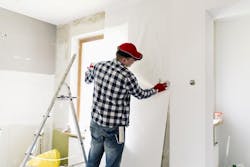While project budgets and sizes have decreased due to the pandemic, new research finds that the remodeling industry will begin to bounce back.
The Joint Center for Housing Studies of Harvard University (JCHS) found that there will be moderate gains to homeowner spending in the coming year. The first quarter of 2020 experienced a 3.3% change in remodeling activity, which dipped down to 2.1% in the second quarter. The third quarter saw a slight increase with 2.2%, but from the fourth quarter of this year until the first quarter of 2021, increases will be higher.
It is predicted that the fourth quarter of this year will see a 3.4% change and continue to a 4.1% change in 2021’s first quarter. But, after the first quarter, it is predicted that remodeling activity will begin to drop from a 4.1% peak.
[ Read More: HOW TO DESIGN A HOME OFFICE, BASED ON CONSUMER RESEARCH ]
“Annual expenditures for renovation and repair of the owner-occupied housing stock are expected to rise from about $332 billion today to $337 billion by the latter half of 2021,” Abbe Will, associate project director in the Remodeling Futures Program at the center, told JCHS. “While a softening of growth is projected in 2021, recent strengthening of home prices and sales activity—including second home purchases—could provide further boosts to remodeling and repair next year.”
These predictions can change, JCHS says, as more Americans become homeowners. There is truly no way to know what the economy will look like in one year, but these upcoming increases appear promising.
Residential remodelers are experiencing a strong demand still, says the National Association of Home Builders (NAHB). While more Americans buy homes, many are content in keeping their property but investing more into remodeling projects.
Due to the strong demand for home improvements, the Remodeling Market Index (RMI) by NAHB hit an 82 for residential remodeler confidence.
[ Read More: WHAT IS THE MOST POPULAR EXTERIOR BUILDING MATERIAL? ]
The confidence survey requires remodelers to rate five different areas of the market as good, fair, or poor, and each question is measured on a scale of zero to 100. An 82 confidence level is seen as extremely high. The bottom-line for a positive outlook is 51.
A subcomponent of the RMI, the Current Conditions Index, hit an average confidence of 86. This index measured confidence of the current conditions of large, moderately-sized, and small remodeling projects. The project with the highest confidence were small projects, which hit a 90.
For the future though, confidence remains high yet not as high. The Future Indicators Index averaged out at 77, which took into account the sentiment toward the rate of leads currently coming in and the backlog of remodeling jobs. More than half of respondents told NAHB the market is better than three months ago.
“The third quarter RMI reading of 82 indicates strong remodeler sentiment, as business has strengthened as homeowners focus on the importance of home for work and life amidst the pandemic and its consequences,” said NAHB Chief Economist Robert Dietz. “However, remodelers are reporting double-digit percentage increases for material pricing, as delays in obtaining materials have become a critical near-term challenge due to disrupted supply-chains. Nonetheless, the third quarter RMI is another indicator showing that housing is the bright spot of the economy.”


